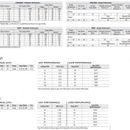ERV – Renewaire EV90 or EV90P
I am looking to install an ERV and am considering a Renewaire EV90 or EV90P, which is the same thing, but has a core twice the size. I will be running about 70CFM continuous, independently ducted.
The EV90P is 7% (ASRE) more efficient at 32F. Not a huge difference. I am just north of Boston with about 6000 HDD, a 11.3 HSPF heat pump, $.16/kWh electric, I estimate the EV90P saves $10 in heating costs per year.
What does the “Total EFF Summer/Winter” number mean? I think they incorporate moisture transfer.
There does seem to be a notable moisture transfer difference. Does that have a meaningful summer latent load management effect?
Is there a compelling case for the EV90P? The price difference is $641.
GBA Detail Library
A collection of one thousand construction details organized by climate and house part










Replies
Look around for a Panasonic FV-10VEC1. You should be able to get it for a couple of bucks more than the EV90 and better performance than both units.
http://www.tcohllc.com/uploads/9/1/7/4/91743468/intelli-balance_brochure_81702_v6.pdf
I've been looking at the Panasonic model as well. I am still learning to decipher these ERV datasheets.
Why does the power consumption go up as the temperature goes down? See the -13F/68 CFM line @84 watts.
The unit goes into recirc mode to defrost so the blower is pushing higher pressure, thus more power.
Thanks, I was thinking the Panasonic data was a typo, defrost was not obvious.
The Panasonic seems nice, particularly at lower flow where the ECM motors start to overcome the high initial wattage. The "self balancing" aspect is cool, you just are going to be burning electricity at higher static pressures.
The filters are super expensive though ($35-$40 ea) and don't appear very big, so they will load quickly.
I am thinking of using Aldes constant flow regulators to balance the Renewaire. I haven't seen this done, but it should work. As the filter loads, the available static pressure will drop and the regulator will adjust to keep the total flow rate constant.
The low pressure version would accommodate the most filter loading.
https://aldes.us/wp-content/uploads/2017/12/car-ii-lp_spec.pdfFF
At 65cfm, we have a bit more than .4 " static to work with. Budget .1" to initial filter and duct, .1" to regulator, .2" to filter loading.
I've seen the Aldes units used a lot for hvac overseas. From what I gather, it is designed for higher static pressure systems, the self balancing doesn't happen until you get above 50Pa. Even then it still has a bit of a slope, I don't think it would be good enough to maintain constant intake and exhaust flow for an ERV.
For better indoor air quality and longer core life, you want good filters. Good filters are never cheap. The foam ones that most H/ERV come with are just not up for the job. I have a Merv13 filter after my ERV, it collects an impressive amount of dust over a year. I've recently hacked a car intake filter in to replace the foam one because of this.
It is also good to put a filter on your return registers. This keeps your return piping clean and really cuts down on the buildup of the filter inside the unit.
P.S. If you are installing a separate fresh air filter box, put it before the unit. This way you are replacing standard furnace filters instead of specialty ERV ones. Just make sure it is insulated.
Ignore ASRE and ATRE. These are efficiency numbers that ignore the energy consumed by the unit itself (mostly fan power). These are "...intended to be utilized where the energy modeling software accounts for HRV and ERV fan or blower energy as a separate input."
https://www.hvi.org/resources/publications/builder-guide/
For true efficiency comparison, look at SRE and TRE.
I would suggest oversizing your ventilator. You want to be able to boost it during periods of higher demand (e.g. you've got company over). I can tell you from experience that even 5 adults in a house with 70cfm of fresh air delivery is going to have CO2 levels through the roof within a couple of hours, perhaps even less. So make sure the unit you choose has the flow capacity, and also the functionality of boost.
You are right, SRE/TRE is what you want to look at and then note the power consumption. ASRE/ATRE are relevant when thinking about comfort or subtracting the power consumption elsewhere.
Does anyone understand what goes into the Renewaire "Core Performance" numbers on their datasheet (copied in photo in first post)? They don't seem to exactly line up with SRE/TRE or ASRE/ATRE. They actually lower than any of those numbers.
I also reviewed my numbers and I think 55CFM would work. I am leaning towards the Panasonic, as you start to get into some low wattage numbers if you keep the statics down and the core performance is very good there.
I am thinking I will add a separate filter box to run standard MERV 13 filters and omit interior filter.